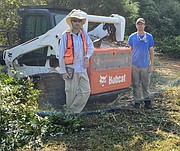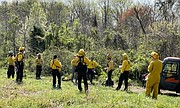Fire and smoke are “managed” to move in desired directions to control fire and minimize smoke outside the field perimeter. Photo by Susan Laume/The Connection
The Connection had a view, from a safe distance on April 7, of Fairfax County Park Authority’s prescribed burn operation. The work, conducted as part of a meadow restoration project, will improve a wildlife habitat area at Laurel Hill Park in Lorton. Signs on nearby roads and at the work area entrance advised the public that smoke could be present. No roads or trails were closed for the day long operation conducted by the County’s Natural Resources Branch.
Preparation began long before the day of the burn over a period of many months. Native plant species, identified by project manager Darko Veljkov, were tagged for protection. In September 2020, Veljkov and lead Ecologist Owen Williams, used a Bobcat to clear the area of heavy brush and non-native trees; some targeted herbicide was also used. (See http://connectionarchives.com, Sept. 24-30, 2020, page 9). Clearing work was done around the perimeter to create a “firebreak,” a gap in vegetation and combustible material, to act as a barrier and stop the progress of fire.
The day of the burn was chosen carefully for conditions of temperature, humidity, and wind velocity, for optimal control of fire and smoke. Trained and certified members of the Natural Resources Branch, and volunteers and contractors experienced in fire management and emergency medical technicians made up a crew of eleven at work on the fire crew. Designated lead, certified Fire Boss, Owen Thomas led a team review of the mapped fire/smoke management plan, radio and call check, equipment and assignments.
Before the fire was set, the fire break was given a renewed clearing by blowing and raking combustible materials out of the break. A “wet line” was laid along the firebreak, and was reapplied periodically. Drip torches were used to begin combustion in the lower portion of the field working back toward the entrance, in a manner that worked with the light wind and forced the fire in on itself. This allowed the smoke to rise straight above the field and minimized smoke reaching trails and outlying areas.
Special fire control tools were used to move the fire, suppressing it as it neared the firebreak.
Fire crew members, some with prior wildfire fighting experience with the National Forest Service, maintained a constant vigil.
The fire was at a relatively low intensity with higher flares as larger piles of dry black berry canes and brush materials were consumed. Williams indicated, “fire intensity can be high at a site that hasn’t been burned before.”
A final sweep assures all hot spots are cooled.By the next day, the meadow presents a cool, empty, ashy palette waiting for nature’s renewal of color and life.
Additional burns may be needed on the same site until hearty invasive plants weaken and don’t regrow in following seasons. Williams predicts any future burns there, if needed, will have lower intensity and less smoke, but with all the same safety protocols in place to assure the continuing success of this important tool for natural resource management.





